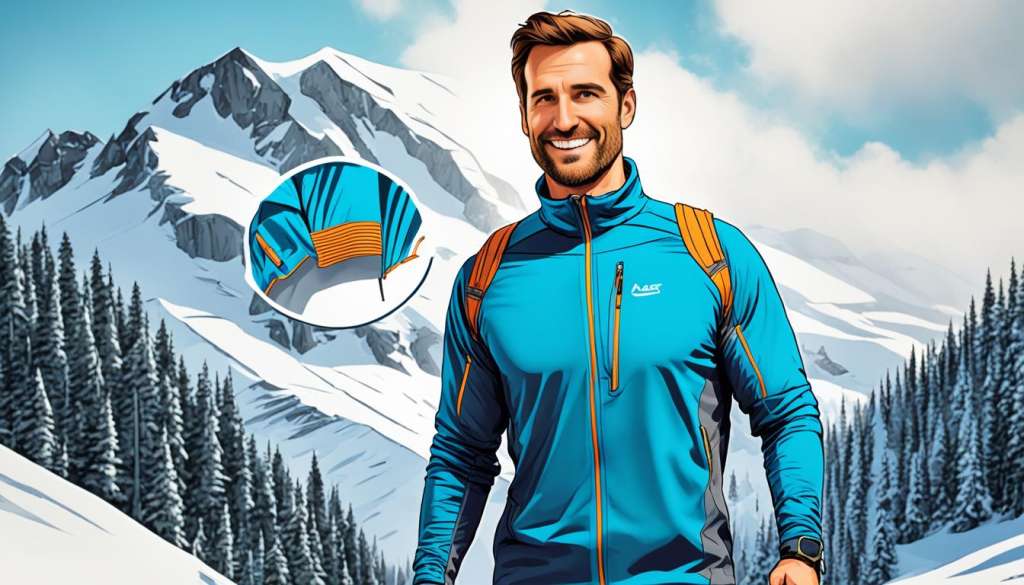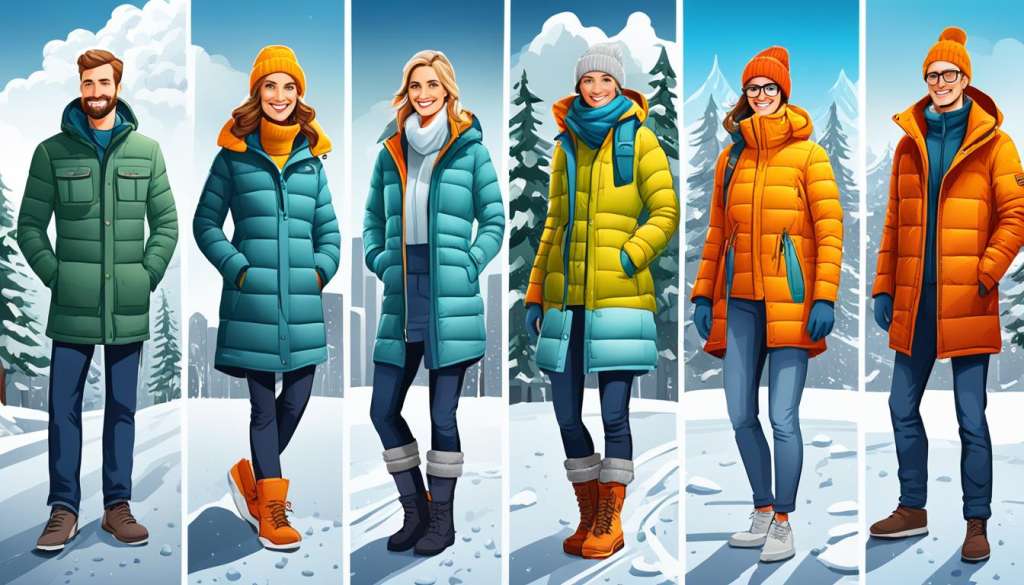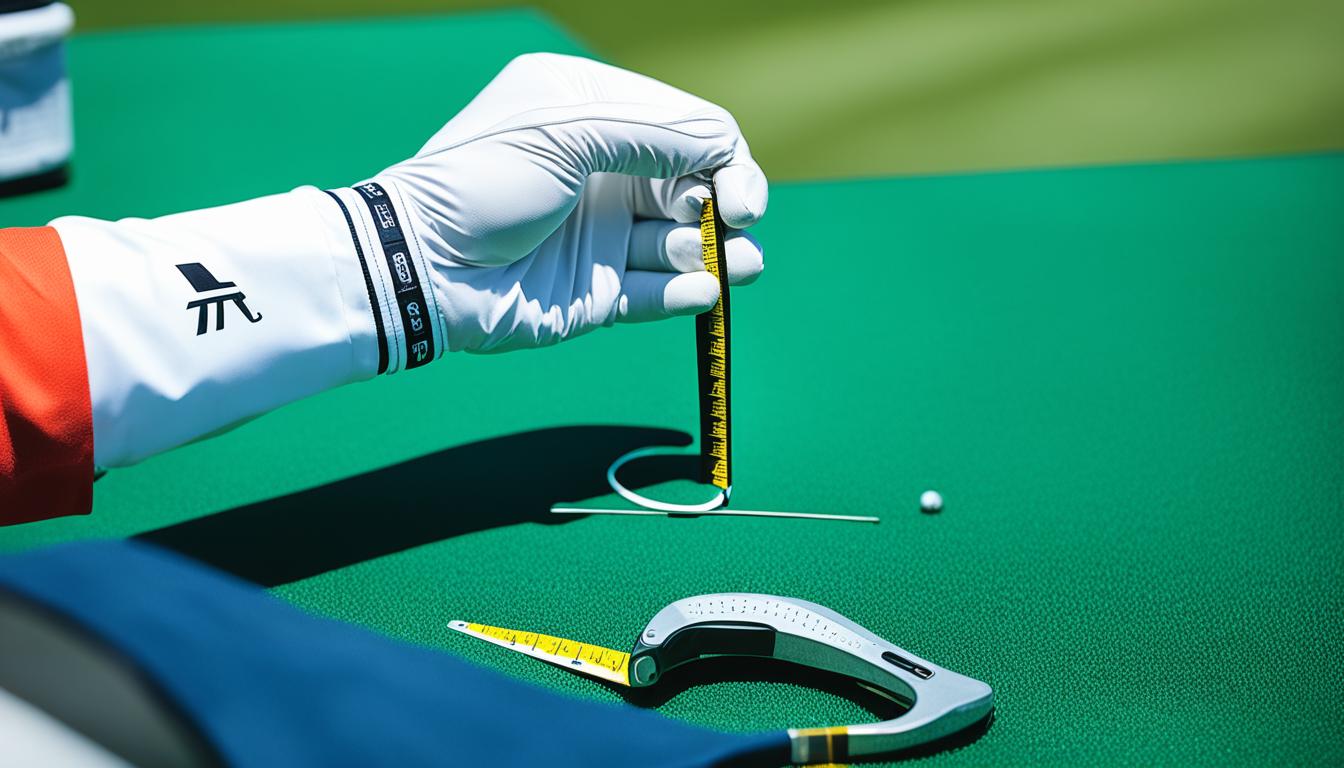Insulating mid-layers are key to your outdoor gear. They keep you warm and comfortable on your adventures. These layers trap heat but let moisture out, keeping you cozy in different weather.
For hiking, skiing, or camping, the right mid-layers are essential. You can choose from fleece jackets, synthetic insulation, down jackets, or merino wool sweaters. Each type suits different activities and preferences. Let’s explore how to pick the best mid-layers for your outdoor needs.
Understanding the Three-Layer Clothing System
The three-layer clothing system is a smart way to dress for the outdoors. It keeps you comfy in different weather. Let’s look at each layer and what it does.
Base Layer: Moisture Management
Your base layer is key for staying comfy. It’s usually made of moisture-wicking fabric, like thermal underwear. This layer keeps you dry by moving sweat away from your skin. You can choose from synthetic materials or merino wool for this layer.
Mid-Layer: Insulation
The mid-layer traps warm air close to your body. It gives you breathable insulation to stay warm. You can pick from fleece jackets, wool sweaters, or synthetic insulated items. They keep you warm without making you feel bulky.
Outer Layer: Weather Protection
Your outer layer protects you from wind, rain, and snow. It should be waterproof and breathable. This layer keeps the insulating mid-layer safe while letting moisture escape.
| Layer | Function | Common Materials |
|---|---|---|
| Base | Moisture management | Synthetic fabrics, merino wool |
| Mid | Insulation | Fleece, wool, synthetic fill |
| Outer | Weather protection | Waterproof/breathable fabrics |
Understanding this system lets you mix and match layers for your activity level and the weather. This way, you can stay comfy in changing conditions.
The Role of Mid-Layers in Temperature Regulation
Mid-layers are key to your outdoor clothing. They stop heat from leaving your body. This keeps warm air close, making you more insulated.
Good mid-layers catch and return your lost body heat. This keeps you warm, even when it’s cold.
When picking a mid-layer, look at its warmth-to-weight ratio. This tells you how warm it is for its weight. A better ratio means it keeps you warm without being heavy.
- Traps warm air near the body
- Redirects escaped heat back to you
- Provides insulation without restricting movement
- Maintains comfort in varying temperatures
Knowing how mid-layers work helps you choose better outdoor gear. The right one keeps you warm and comfy. This makes outdoor adventures more fun, no matter the weather.
Types of Insulating Mid-Layers
Choosing the right mid-layer is key to a great outdoor experience. Let’s look at four popular types to help you stay warm and comfy on your adventures.
Fleece Jackets
Fleece jackets are a top pick for outdoor lovers. They’re light, dry fast, and trap air to keep you cozy. Perfect for mild to cool weather, they’re great alone or under a shell.
Synthetic Insulated Jackets
Synthetic insulated jackets are versatile and reliable. They stay warm when wet, making them perfect for unpredictable weather. These jackets breathe well, letting moisture out during active times.
Down Jackets
Down jackets are known for their warmth and lightness. They’re ideal for cold, dry weather. But remember, down loses its insulating power when it gets wet, so choose wisely.
Merino Wool Sweaters
Merino wool sweaters offer natural insulation with extra perks. They breathe, wick away moisture, and fight odors naturally. Great for long trips or versatile layering in various conditions.
| Mid-Layer Type | Best For | Key Feature |
|---|---|---|
| Fleece Jackets | Mild to cool weather | Quick-drying |
| Synthetic Insulated Jackets | Wet conditions | Insulates when damp |
| Down Jackets | Cold, dry conditions | Excellent warmth-to-weight ratio |
| Merino Wool Sweaters | Multi-day trips | Odor-resistant |
Think about your activity level, climate, and what you like when picking an insulating mid-layer. Each type has its own benefits, so mixing them might be best for your outdoor adventures.
Key Features to Look for in Mid-Layer Clothing
When picking a mid-layer, think about several key features. The right one can greatly improve your comfort and performance outdoors.

Warmth is essential. Your mid-layer should keep you warm in the cold. Look for materials that trap air well, keeping the cold out.
Breathability is key for staying comfortable while active. A good mid-layer lets moisture out, so you don’t get sweaty. It should also dry quickly to keep you dry during intense activities.
Weight matters too. A light mid-layer is perfect for activities like backpacking or climbing. It should keep you warm without adding bulk.
Zips are handy in mid-layers. Full-length front zips let you control your temperature easily. You can open them when you’re too warm and close them when it gets cold again.
| Feature | Importance | Benefit |
|---|---|---|
| Warmth | High | Keeps you comfortable in cold conditions |
| Breathability | High | Prevents overheating and moisture buildup |
| Quick-drying | Medium | Keeps you dry during active pursuits |
| Weight | Medium | Reduces overall load for activities like backpacking |
| Zips | Low | Allows for easy temperature adjustment |
Avoid cotton mid-layers because they hold moisture. Choose materials made for outdoor use to stay comfortable in different conditions.
Top Picks for Insulating Mid-Layers
Choosing the right insulating mid-layer is key to a great outdoor experience. We’ve picked three top options for different needs and budgets.
Best Overall: Arc’teryx Atom Jacket
The Arc’teryx Atom Jacket is a top choice for many. It’s warm without being too bulky, perfect for various activities. The breathable side panels help prevent overheating when you’re moving fast.
Budget-Friendly Option: Columbia Steens Mountain 2.0
If you’re watching your budget, the Columbia Steens Mountain 2.0 is a great pick. It’s a fleece jacket that keeps you warm in mild weather. It’s ideal for casual hikes or layering up in the cold.
Ultralight and Packable: Patagonia Micro Puff Jacket
The Patagonia Micro Puff Jacket is ideal for those who want to save weight. It has innovative insulation that’s both warm and light. This jacket also packs down small, making it perfect for backpackers and climbers.
| Jacket | Best For | Insulation Type | Weight |
|---|---|---|---|
| Arc’teryx Atom Jacket | All-around use | Synthetic | 13.2 oz |
| Columbia Steens Mountain 2.0 | Casual outings | Fleece | 16.6 oz |
| Patagonia Micro Puff Jacket | Ultralight activities | PlumaFill synthetic | 8.3 oz |
Each jacket has its own special features. Think about what you need and what you’ll be doing outside. The best mid-layer is one that keeps you comfy in your outdoor adventures.
Insulating Mid-layers Guide: Choosing the Right Option for Your Activity
Choosing the right mid-layer is key to staying comfortable outside. It depends on what you’ll be doing and the weather. Performance mid-layers have special insulation for different outdoor activities.
For activities like backcountry skiing or trail running, you need breathable mid-layers. These let sweat out while keeping you warm. The Patagonia R1 Air is a great example, keeping you dry and warm during tough activities.
In cold, dry places, down jackets are best for staying warm. The Arc’teryx Cerium is a top choice, perfect for activities like winter camping or ice fishing.
- Activity intensity
- Expected weather conditions
- Personal temperature preferences
- Duration of outdoor excursion
Here’s a table with mid-layer suggestions for different activities:
| Activity | Recommended Mid-Layer | Key Features |
|---|---|---|
| Hiking | Fleece jacket | Breathable, quick-drying |
| Skiing | Synthetic insulated jacket | Warm, moisture-resistant |
| Rock Climbing | Lightweight merino wool sweater | Flexible, odor-resistant |
| Winter Camping | Down jacket | Extremely warm, compressible |
Choosing the right mid-layer for your activity and conditions ensures you stay comfortable and perform well outside.
Breathable insulation is key for comfort in mid-layers. These garments are vital for managing moisture, keeping you dry during outdoor activities. Let’s see how breathable fabrics and sweat-wicking properties work together to improve your layering system.
The Importance of Breathable Fabrics
Breathable fabrics let water vapor escape, preventing overheating and moisture buildup. This is key for keeping your body temperature stable and comfortable during exercise. Mid-layers made from polyester or merino wool are great examples of breathable materials.
Moisture-Wicking Properties
Sweat-wicking technology changes the game in mid-layer clothing. These fabrics pull moisture from your skin to the outside, where it can evaporate fast. This keeps you dry and comfy, even when you’re really active.
| Material | Breathability | Moisture-Wicking | Drying Time |
|---|---|---|---|
| Synthetic (Polyester) | High | Excellent | Fast |
| Merino Wool | Very High | Good | Moderate |
| Cotton | Low | Poor | Slow |
For the best moisture management, pick mid-layers with breathable insulation and sweat-wicking properties. This combo will keep you dry, comfy, and ready for any outdoor adventure.
Layering Strategies for Different Weather Conditions
Learning how to layer your clothes is key to staying comfortable outside. You need to adjust your layers for different weather to avoid being too hot or too cold. Let’s look at how to layer for various climates.

For cold weather, begin with a thin, moisture-wicking base layer. Then, add a fleece mid-layer for extra warmth. Finish with a down or synthetic jacket and a waterproof shell. This setup keeps you warm and lets moisture escape.
For mild weather, choose a light base layer and a single mid-layer. A fleece jacket or merino wool sweater works great. This way, you stay warm but won’t get too hot during activities.
When the weather is unpredictable, focus on layers you can easily change. A zip-up fleece or a lightweight insulated vest is perfect for this. You can add or remove them as needed.
- Cold weather: Base layer + Fleece + Insulated jacket + Shell
- Mild conditions: Light base layer + Single mid-layer
- Changeable weather: Adjustable layers for versatility
The secret to good layering is being flexible. Watch your body temperature and adjust your layers. With time, you’ll get your layering just right for any weather.
Caring for Your Insulating Mid-Layers
Looking after your mid-layers the right way makes them last longer. By using these cleaning and storage tips, your insulated jackets will stay in great shape for many years.
Cleaning and Maintenance Tips
Cleaning your outdoor gear needs special attention. For synthetic mid-layers, wash them in cold water and let them air dry. Down jackets should be cleaned with a special down detergent and dried with tennis balls to keep them fluffy. Always look at the care label before you start cleaning.
- Synthetic jackets: Machine wash cold, tumble dry low
- Down jackets: Use down-specific detergent, dry with tennis balls
- Fleece: Wash separately to prevent lint transfer
- Merino wool: Hand wash or use gentle cycle, lay flat to dry
Proper Storage Techniques
Storing your mid-layers right helps keep them warm. Keep them in a cool, dry spot, and don’t squish them for a long time. This is very important for down items, as they can lose their insulating power if stored wrong.
| Mid-Layer Type | Storage Method | Key Consideration |
|---|---|---|
| Down Jackets | Hang or store loosely in breathable bag | Avoid compression |
| Synthetic Insulation | Fold or hang | Keep away from heat sources |
| Fleece | Fold or hang | Store in dark place to prevent fading |
| Merino Wool | Fold with tissue paper | Use cedar blocks to deter moths |
By taking good care of your mid-layers, they will stay effective and last longer. This means they’ll be ready for your next adventure.
Conclusion: Maximizing Comfort with the Right Mid-Layer
Finding the perfect mid-layer is essential for outdoor comfort and keeping warm. Your choice greatly affects your outdoor experience. It’s important to think about the activity, the weather, and what feels good for you.
The layering system does more than just keep you warm. It lets you adjust easily to changes in weather and activity levels. By getting good at layering, especially with your mid-layer, you’ll be prepared for anything nature brings.
There’s no single best choice for everyone. Brands like Arc’teryx, Columbia, and Patagonia have many options. Whether you like fleece, synthetic insulation, down, or merino wool, the right mid-layer is waiting for you. With what you now know, you can choose wisely and enjoy your outdoor adventures comfortably.

